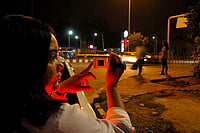Death, in fact, many deaths, loom large over Mira Jacob’s debut novel The Sleepwalker’s Guide To Dancing. Yet, the novel never feels weighed down by its dark moments, in Jacob’s sure hand, the narrative moves soft as breeze. The novel opens with a prologue where a mother complains to her daughter about her father’s latest shenanigans, affectionately, of course, and not without dollops of wry humour. It’s enough to pull you into their story, buoyant with everyday conversations that are comic, tragic, and often both.
Hailed as the new Jhumpa Lahiri, Jacob soars with a voice entirely her own, less bleak and more vibrant. The themes are similar—of the Indian immigrant experience in America as they make their way about, as Jacob puts it, “a stolen country”. We follow the lives of the Eapens, a family of four, Syrian Christians who’ve made the stark landscape of Albuquerque, New Mexico, their home. The book moves seamlessly between Salem, Tamil Nadu, in the late ’70s, the place where the extended Eapen family is based, and Albuquerque in the ’80s and ’90s, with flashes of Seattle.
Though not written in first person, this is, in many ways, the story of the Eapens as observed by their younger child, Amina. She’s only 11 when she witnesses the extended family fall apart, and a little older when a serious tragedy strikes the family. She observes fragile relationships become more fragile. Her older brother, Akhil, her housewife mother, Kamala, her brain surgeon father, Thomas, are like characters in a play, as Amina watches from the wings, underestimating the power of her own mind. When tragedy strikes the family yet again, Amina is in her teens, watching her parents struggling to cope, and left to her own devices. She emerges some 15 years later as a reserved, under-confident but talented photographer based in Seattle. She’s trying to deal with a professional crisis of her own when her mother, Kamala, shakes her up with some fresh, disturbing news: her father has apparently been talking to his dead mother and other relatives out on the porch in the dead of the night. It’s time for her to make the journey home to Albuquerque, Amina decides, to set things right.
But as often is the case with complex family matters, some things can never be set ‘right’. And so discovers Amina, over the next few months, as the Eapen nucleus as she knows it comes undone, haunted by an almost unspeakable past. It seems easier for Jacob’s characters to sleeptalk, sleepwalk, or as in the case of Thomas, not sleep at all. That metaphor runs through the novel like a knife, cutting deep into the heart of an otherwise regular, middle-class Indian family in a land not quite their own.
Jacob captures the discomfort of her characters with themselves and their world with a keen sense of having been there. The novel is not exactly autobiographical, but there are similarities between Jacob’s life and the Eapen story. That gives her an edge, allowing her to create characters that are full-bodied, flawed and endearing in their various quirks. As Amina’s life unravels towards the end of the novel, it also comes together in many ways, leaving many loose ends while tying up a few others. Isn’t life like that?


























